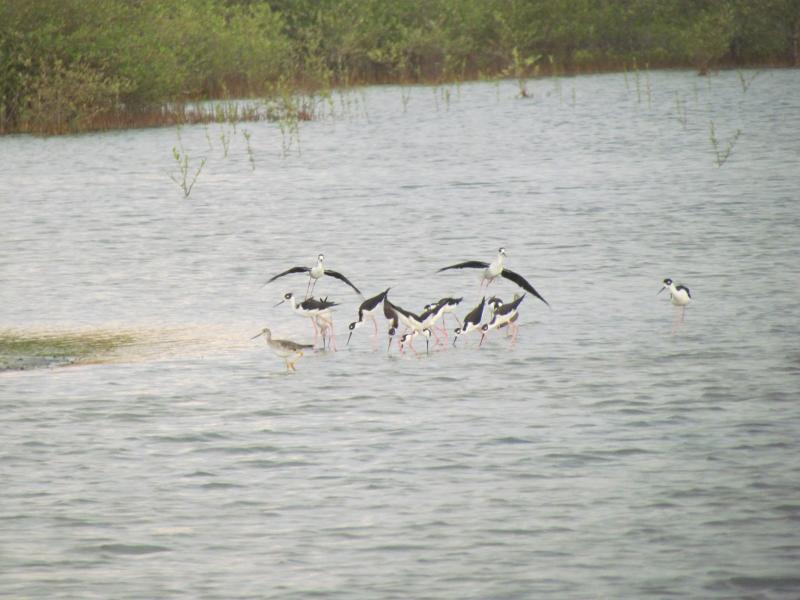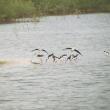The Exciting Birds of Pop-up Ponds
 The authors were pleasantly surprised to see some of these beautiful little ducks--green-winged teal--in the temporary pond that forms in a farm field in Richmond, Maine.Photo by Dick Daniels (http://carolinabirds.org/), CC BY-SA 3.0 , via Wikimedia Commons.
The authors were pleasantly surprised to see some of these beautiful little ducks--green-winged teal--in the temporary pond that forms in a farm field in Richmond, Maine.Photo by Dick Daniels (http://carolinabirds.org/), CC BY-SA 3.0 , via Wikimedia Commons.
 This greater yellowlegs, on its way north to the Boreal Forest region of Canada to nest, stopped by the authors’ favorite pop-up pond in Richmond last April. Courtesy of Jeff Wells.
This greater yellowlegs, on its way north to the Boreal Forest region of Canada to nest, stopped by the authors’ favorite pop-up pond in Richmond last April. Courtesy of Jeff Wells.
 Pop-up wetlands on Aruba, where this photo was taken, can be teeming with shorebirds like this flock of black-necked stilts landing near a single greater yellowlegs. Courtesy of Jeff Wells.
Pop-up wetlands on Aruba, where this photo was taken, can be teeming with shorebirds like this flock of black-necked stilts landing near a single greater yellowlegs. Courtesy of Jeff Wells.
 The authors were pleasantly surprised to see some of these beautiful little ducks--green-winged teal--in the temporary pond that forms in a farm field in Richmond, Maine.Photo by Dick Daniels (http://carolinabirds.org/), CC BY-SA 3.0 , via Wikimedia Commons.
The authors were pleasantly surprised to see some of these beautiful little ducks--green-winged teal--in the temporary pond that forms in a farm field in Richmond, Maine.Photo by Dick Daniels (http://carolinabirds.org/), CC BY-SA 3.0 , via Wikimedia Commons.
 This greater yellowlegs, on its way north to the Boreal Forest region of Canada to nest, stopped by the authors’ favorite pop-up pond in Richmond last April. Courtesy of Jeff Wells.
This greater yellowlegs, on its way north to the Boreal Forest region of Canada to nest, stopped by the authors’ favorite pop-up pond in Richmond last April. Courtesy of Jeff Wells.
 Pop-up wetlands on Aruba, where this photo was taken, can be teeming with shorebirds like this flock of black-necked stilts landing near a single greater yellowlegs. Courtesy of Jeff Wells.
Pop-up wetlands on Aruba, where this photo was taken, can be teeming with shorebirds like this flock of black-necked stilts landing near a single greater yellowlegs. Courtesy of Jeff Wells.
Birders often talk about their favorite birding “patches.” By that they mean the local places that they regularly frequent. Often these are not the well-known birding hotspots but some small park, preserve, or other location that is close enough and accessible enough that it is easy to stop by frequently.
Readers of this column may have surmised that one of our favorite birding “patches” is an area of farm fields in Richmond. We enjoyed seeing a rough-legged hawk there this winter and were surprised that an American kestrel was able to make it through the cold temps as well. Later in the spring we will expect to see and hear the sizzling songs of savannah sparrows with their yellowish eyelines and short tails, and the bubbling songs of male bobolinks decked out in black, white, and gold.
This time of year, though, we love the excitement of checking what we call our “pop-up pond”--the shallow ephemeral wetland pond that forms in one low place beside the road. After significant rains the pond spreads out to make a rough circle of perhaps 200-300 yards in diameter. It is likely only about two feet deep at the center, and most of it is probably just inches deep. And it sometimes only lasts for a day or two.
After the last rain a few days ago, we stopped by at this temporary puddle and there along the farther edge, with the ever-present mallards, were seven handsome wood ducks, our second sighting of the year as we had just seen our first ones only 30 minutes before over in the Kennebec River. Today when we checked our little ephemeral pond, we were blessed with two American wigeon and nine resplendent green-winged teal. Two killdeer were strolling along its edges as well.
This little pop-up pond, when it’s there, can be amazingly productive for birds. Last spring, we saw bufflehead on it one day and northern pintail another. In April we have seen lesser and greater yellowlegs together in that same spot, with swarms of tree swallows and barn swallows overhead.
It is only if you visit a place frequently that you may even know that a temporary wetland pond can form there. These transient wetlands clearly are important for birds that need a place to stop, rest, and feed in migration, even if only for a few hours.
We have noticed the same type of phenomena far away from Maine and in the very different and usually incredibly hot and dry environment of Aruba, Bonaire, and Curaçao. These arid islands that lie just off the coast of Venezuela can sometimes go months without significant rain. When the rain does come, it can quickly pool up on the landscape to form small temporary shallow ponds, on the islands, typically called salinas. Within days these salinas can be filled with shorebirds. The deeper, longer lasting of these suddenly appearing ponds can host wintering blue-winged teal and, if they last long enough, nesting white-cheeked pintails as well as pied-billed and least grebes.
Just as vernal pools are vital places for breeding salamanders and frogs and aquatic insects, pop-up ponds and other kinds of appearing-out-of-nowhere wetland ponds are important for migrating (and in some places, for breeding) birds. Birders who know where they form can also have the fun of checking them during and after rain events to make cool discoveries of birds that they might not have expected.
Hope you are all enjoying your favorite birding “patches” as much as we are!
Jeffrey V. Wells, Ph.D., is a Fellow of the Cornell Lab of Ornithology and Vice President of Boreal Conservation for National Audubon. Dr. Wells is one of the nation's leading bird experts and conservation biologists and author of the “Birder’s Conservation Handbook.” His grandfather, the late John Chase, was a columnist for the Boothbay Register for many years. Allison Childs Wells, formerly of the Cornell Lab of Ornithology, is a senior director at the Natural Resources Council of Maine, a nonprofit membership organization working statewide to protect the nature of Maine. Both are widely published natural history writers and are the authors of the popular books, “Maine’s Favorite Birds” (Tilbury House) and “Birds of Aruba, Bonaire, and Curaçao: A Site and Field Guide,” (Cornell University Press).






































